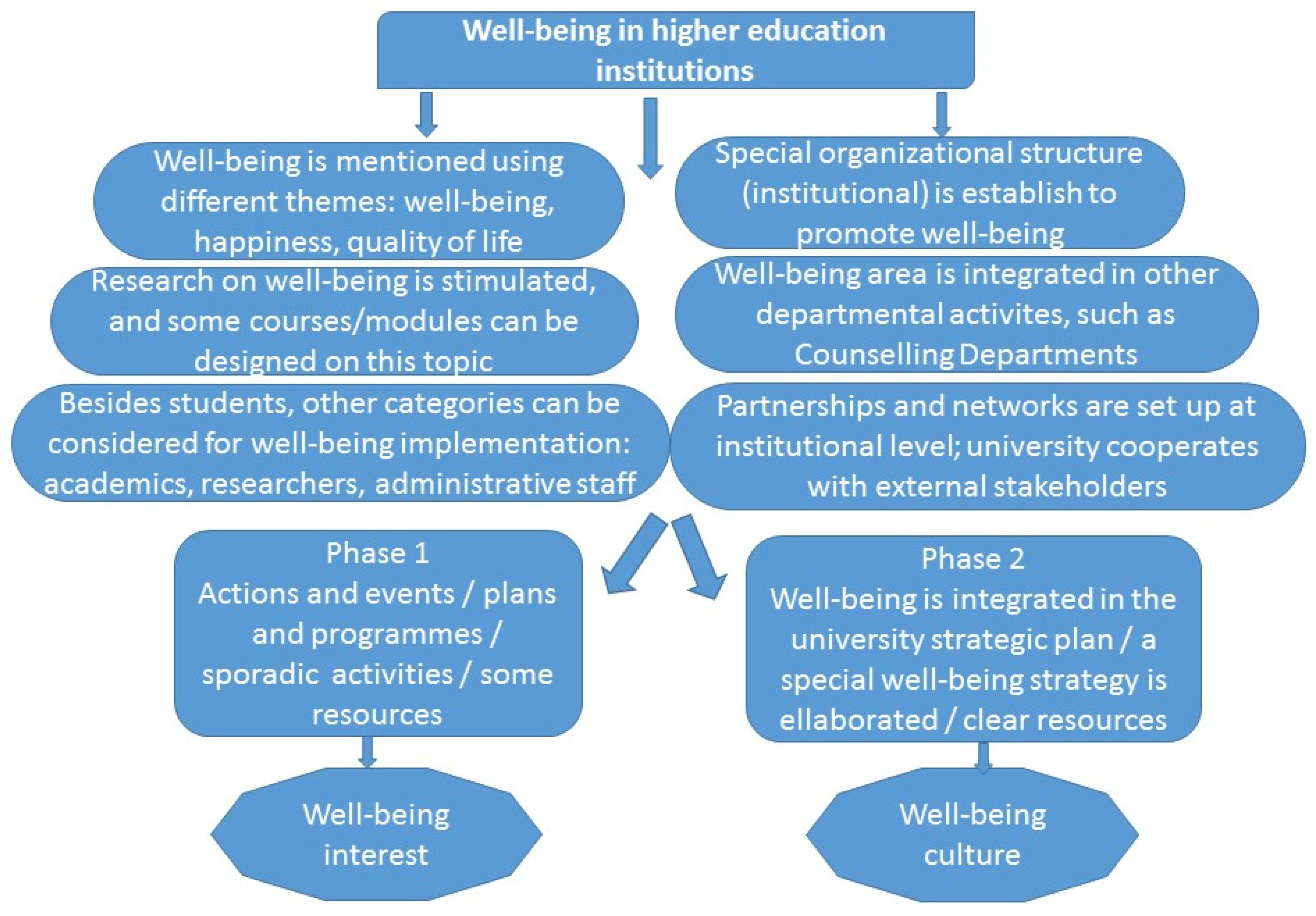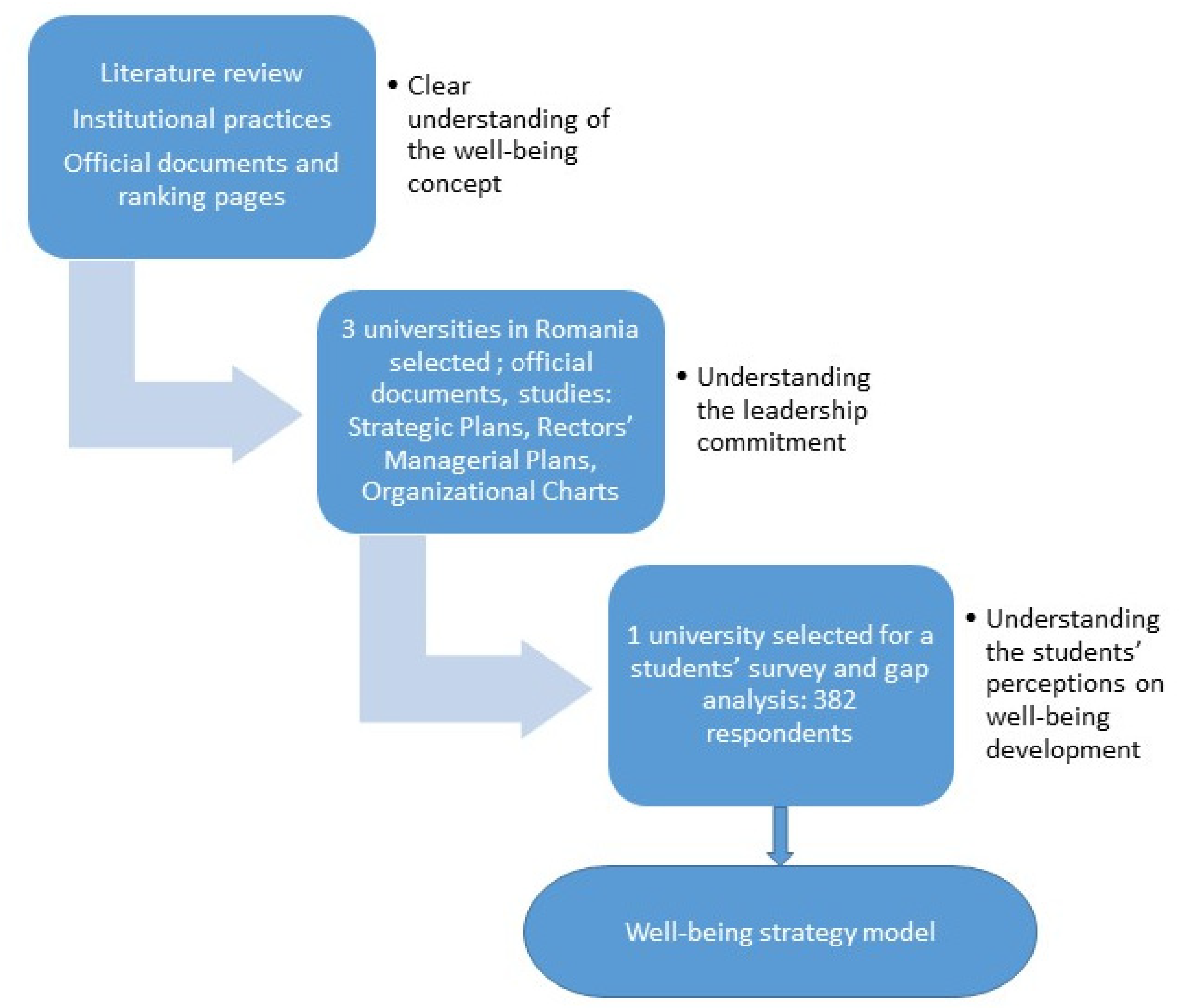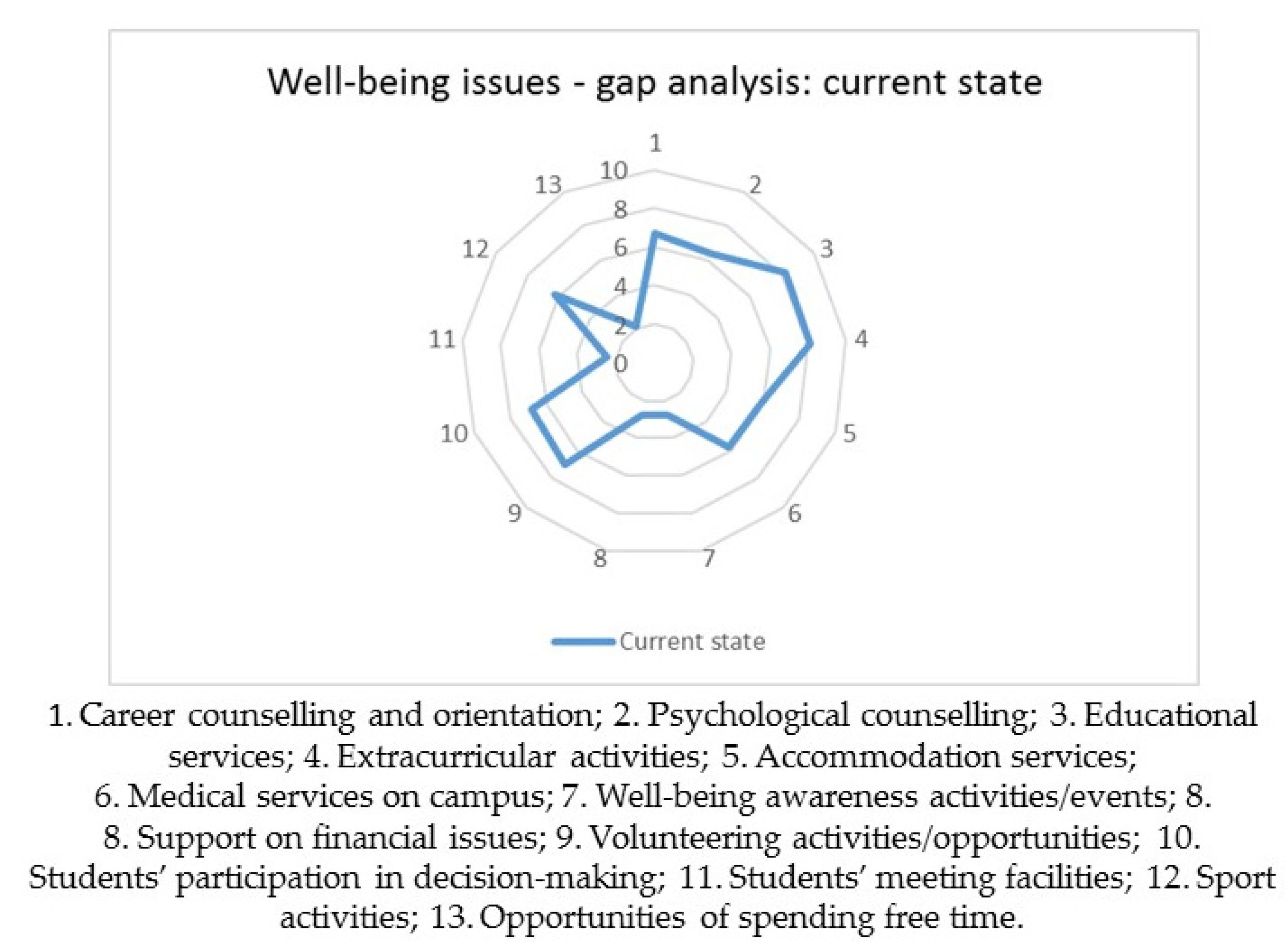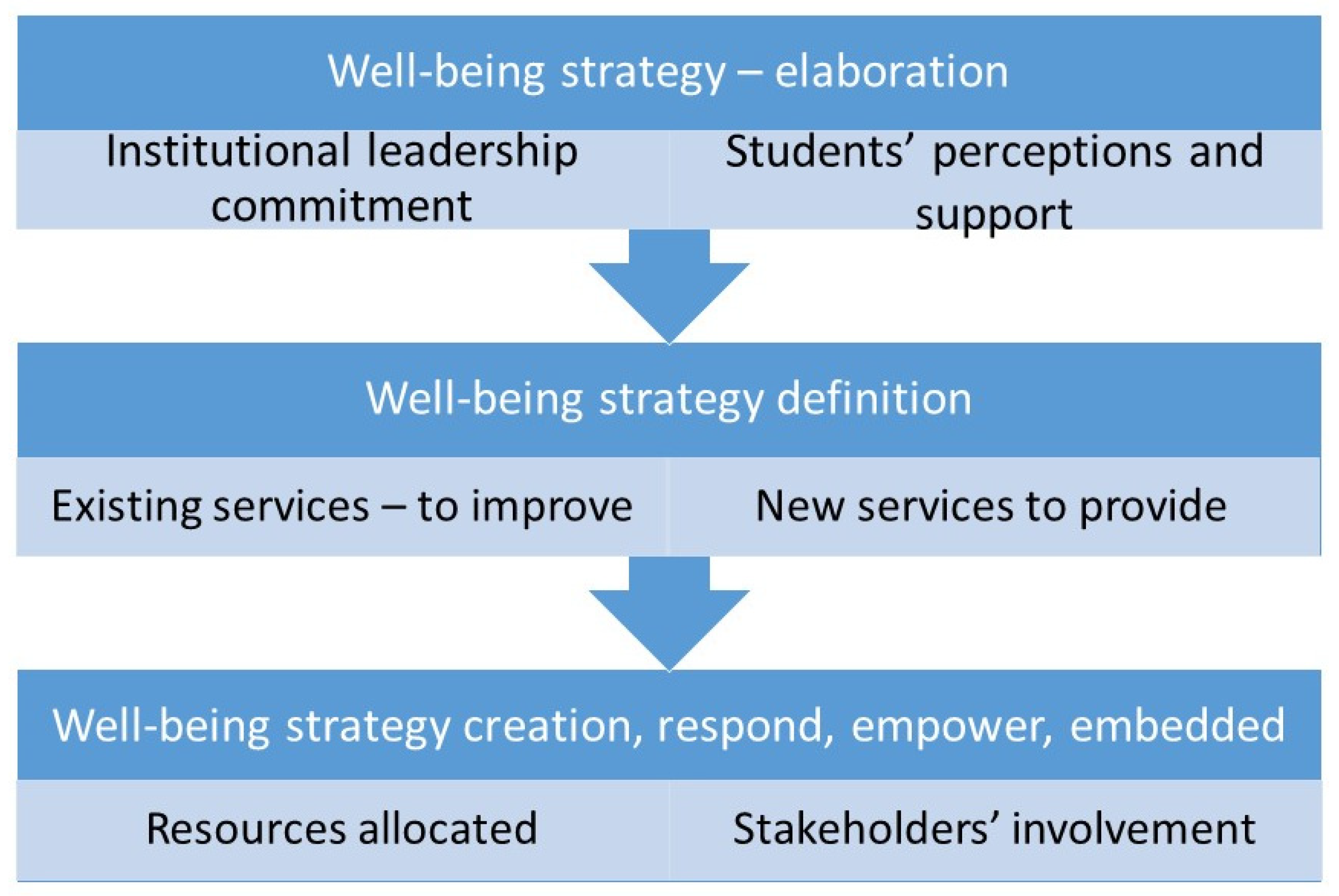Strategy for Well-Being in Universities: A Romanian Higher Education Approach
Abstract
:1. Introduction
2. Literature Review and Conceptual Analysis
2.1. Well-Being and Student Services in Higher Education
- According to the methodology of Princeton Review’s College Ranking, a survey was conducted to find the students’ perceptions on eight areas: Academics/Administration, Quality of Life, Politics, Campus Life, Town Life, Extracurriculars, Social Scene, and Schools by Type. The Happiest Students survey is part of the second area abovementioned and is a collection of answers to simple questions; the latest list (August 2020) ranks Kansas State University as the first institution with the happiest students in the US [27,28];
- Another American ranking considering the freshmen retention rates and overall graduation rate provides a list for the “Top 10 Colleges and Universities with the Happiest Freshmen”; the latest report places Wellesley College first [29];
- A European student satisfaction survey dedicated to analyzing the students’ study experience reported Finland as the best place to study and provided some recommendations for quality improvement, such as teaching by accepting a higher class diversity and employing more student-centered methods [30];
- According to the “Top 10 Study Abroad Countries in Europe—2019 Rankings”, Spain is the most preferred place to study due to the attractiveness of the language, places to visit, culture, climate, career future, and nearby cities [31].
2.2. University Practices on Well-Being Services to Students
2.3. Building a Strategy in Higher Education
3. Methodology
3.1. Research Methodology—Objectives, Questions and Methods
- The first-ranked university is a medical university (founded in 1879) which runs programs directly integrated in the field of health and well-being; therefore, the research is much more aligned with this domain [45]; this will be Univ 1;
- The second-ranked university (founded in 1945) in 2020 is in the same medical area, and thus, the interest in the health and well-being is also direct [46]; this will be Univ 2;
- The third-ranked university (founded in 1864) is not a medical institution, but rather an all-rounder one with study programs in the socioeconomic field, philology, exact science, and earth sciences; thus, its presence in the ranking demonstrates the leadership interest in well-being, ranking class, and place being a consequence of regular activities institutionally run [47]; this will be Univ 3.
3.2. Institutional Documents Analysis
3.3. Questionnaire Design and Gap Analysis
4. Results
- There is no declarative direct interest in well-being, but for providing complex, diverse, and quality services to students;
- Universities are willing to find resources for strategies and define priorities for the entire term of the rector;
- There is a general consent on the fact that students are the most valuable stakeholders, and the relationship with students is seen as a valuable partnership.
- More rooms and facilities for student clubs and societies—168/382;
- More free time/less time spent in class—156/382;
- Better quality for accommodation—135/382;
- Part-time jobs for students on campus—102/382
- Sport/exercise facilities—89/382;
- Trips organized in collaboration and with the other faculties—88/382;
- Financial support services—75/382;
- Training/workshops for leisure (cooking classes, foreign language classes, dancing classes, etc.)—68/382;
- Debates on issues raised by students—54/382;
- More responsibilities for students—they should have some activities to manage fully where they could represent their colleagues—56/382;
- Free resources available for students to access (i.e.,: emotional health support services)—54/382.
5. Discussion and Conclusions
- Conceptual clarifications on well-being, especially considering the similar concepts to happiness and quality of life;
- Understanding of the two phases at an institutional level in delivering student services—different events or strategic approach;
- Well-being strategy can be considered as a change process developed internally;
- Student services must be developed considering their characteristics of being an academic or non-academic individual based on or off campus;
- A huge interest in reporting data and providing evidence for the SDG 3: Good Health and Well-Being for higher education institutions, as revealed in the THE Impact ranking;
- Romanian universities becoming committed to SDG 3 Health objectives, as the number of universities evaluated on this matter increased over years;
- Universities’ good practices which can be an excellent source of information for other similar entities when developing a well-being strategy.
- The academic commitment for specific objectives can be analyzed from strategic university documents and website pages;
- The academic community must be involved in the change process;
- Students are important partners in developing strategies and actions, especially when these have a direct impact on their life;
- Students are aware of what they need in order to be happier whilst in university;
- Students are correctly evaluating their level of satisfaction, but they are also well suited to provide solutions;
- A well-being strategy has to start from a pilot analysis to encourage community openness to change in order to have the fundamentals for strategy elaboration;
- The strategy model as an introductory model provides a clear framework for future development towards well-being;
- Many of the Romanian universities submit data on sustainability issues (for instance for specific rankings) as people/departments are already in charge of providing evidence and indicators specific to sustainability issues, including well-being efforts; sustainability efforts do not translate to financial efforts, but also human resource efforts and ethical commitment from the entire academic community;
- Universities must redefine their role in promoting change towards student well-being; this change is possible by defining strategic goals and integrating them in the general university strategy;
- The studied university demonstrated resilience and acceptance towards developing well-being services for their students, as the questionnaire results had shown.
Author Contributions
Funding
Acknowledgments
Conflicts of Interest
References
- The Challenges of Higher Education in the 21st Century. Available online: http://www.guninetwork.org/articles/challenges-higher-education-21st-century (accessed on 28 August 2020).
- United Nations Report of the World Summit on Sustainable Development Johannesburg, South Africa, 26 August–4 September 2002. Available online: https://digitallibrary.un.org/record/478154/files/A_CONF-199_20-EN.pdf (accessed on 28 August 2020).
- Dayakar, D. Role of Education in Human Development; A Perspective Foundation for Holistic Responsibility; Create Space Independent Publishing Platform: Scotts Valley, CA, USA, 2016. [Google Scholar]
- Renshaw, P.; Power, C. The Process of Learning and Human Development. In International Handbook of Educational Research in the Asia-Pacific Region; Springer: Berlin/Heidelberg, Germany, 2003; pp. 351–363. [Google Scholar]
- Idris, F.; Hassan, Z.; Ya’acob, A.; Gill, S.K.; Awal, N.A.M. The role of education in shaping youth’s national identity. UKM Teaching and Learning Congress 2011. Proced. Soc. Behav. Sci. 2012, 59, 443–450. [Google Scholar] [CrossRef] [Green Version]
- Dahl, A.L. Human Development: A Vision of Well-being. In Proceedings of the International Environment Forum, Geneva, Switzerland, 27 December 2012. [Google Scholar]
- Gross National Happiness. Available online: https://www.gnhc.gov.bt/en/wp-content/uploads/2017/05/GNH-FAQs-pdf.pdf (accessed on 29 August 2020).
- THE Impact Rankings 2020 by SDG: Good Health and Well-Being (SDG 3) Methodology. Available online: https://www.timeshighereducation.com/impact-rankings-2020-sdg-good-health-and-well-being-sdg-3-methodology (accessed on 29 August 2020).
- Impact Rankings: Good Health and Well-Being. 2020. Available online: https://www.timeshighereducation.com/rankings/impact/2020/good-health-and-well-being#!/page/0/length/25/sort_by/rank/sort_order/asc/cols/undefined (accessed on 29 August 2020).
- Impact Rankings 2019 by SDG: Good Health and Well-Being. Available online: https://www.timeshighereducation.com/rankings/impact/2019/good-health-and-well-being#!/page/0/length/25/sort_by/rank/sort_order/asc/cols/undefined (accessed on 29 August 2020).
- Ciobanu, A. The Role of Student Services in the Improving of Student Experience in Higher Education. Lumen International Conference Logos Universality Mentality Education Novelty (LUMEN 2013). Proc. Soc. Behav. Sci. 2013, 92, 169–173. [Google Scholar] [CrossRef] [Green Version]
- Cannon, T. Promoting Student Wellbeing. 2017. Available online: https://www.redbrickresearch.com/2017/11/30/promoting-student-wellbeing/ (accessed on 29 August 2020).
- GuildHE. Wellbeing in Higher Education; A GUILDHE Research Report; GuildHE Woburn House: London, UK, 2018. [Google Scholar]
- Improving the Efficiency of Student Services. Student Led Services. Student Support Service Centres. Available online: https://lottilotti.wixsite.com/impress_lotti/student-led-services (accessed on 29 August 2020).
- Cole, J. How Universities Can Use Support Services to Attract More Students. 2019. Available online: https://www.keystoneacademic.com/news/how-universities-can-improve-and-promote-support-services-to-attract-more-students (accessed on 29 August 2020).
- O’Farrell, L.; Maguire, T. Developing a National, Student-Centred Understanding of Student Success in Irish Higher Education. EUROPEAN LEARNING & TEACHING FORUM. EUA. 2020. Available online: https://eua.eu/downloads/publications/2020.1.12%20ofarrell_maguire.pdf (accessed on 29 August 2020).
- Standards and Guidelines for Quality Assurance in the European Higher Education Area (ESG). 2015. Available online: https://enqa.eu/wp-content/uploads/2015/11/ESG_2015.pdf (accessed on 29 August 2020).
- Methodology for External Evaluation, Standards, Benchmarks and List of Indicators Performance of the Romanian Agency for Quality Assurance in Higher Education. Available online: https://www.aracis.ro/wp-content/uploads/2019/07/Metodologie_Mof_25_2018.pdf (accessed on 29 August 2020).
- Baranova, P.; Mutton, J.; Morrison, S. Enhancing the student experience through service design. The University of Derby approach. Perspectives 2011. [Google Scholar] [CrossRef]
- The Student Life Concept. Available online: https://www.jyu.fi/studentlife/en/the-student-life-concept (accessed on 29 August 2020).
- The Good University Guide. Available online: https://www.gooduniversitiesguide.com.au/study-information/student-life/student-services-and-facilities (accessed on 29 August 2020).
- Stanton, A.; Zandvliet, D.; Dhaliwal, R.; Black, T. Understanding Students’ Experiences of Well-Being in Learning Environments. High. Educ. Stud. 2016, 6, 90–99. [Google Scholar] [CrossRef]
- Well-Bing Concepts. Content Source: National Center for Chronic Disease Prevention and Health Promotion Division of Population Health. 2018. Available online: https://www.cdc.gov/hrqol/wellbeing.htm#:~:text=There%20is%20no%20consensus%20around,with%20life%2C%20fulfillment%20and%20positive (accessed on 29 August 2020).
- Well-Being Concept. Contemporary Health Issues. Available online: https://courses.lumenlearning.com/suny-contemporaryhealthissues/chapter/discussion-questions/ (accessed on 29 August 2020).
- Anand, P. Happiness, Well-Being and Human Development: The Case for Subjective Measures; United Nations Development Programme: New York, NY, USA, 2016. [Google Scholar]
- OECD. Students’ Well-Being: What It Is and How It Can Be Measured; PISA 2015 Results; OECD: Paris, France, 2017. [Google Scholar]
- The Princeton Review’s College Ranking Methodology. Available online: https://www.princetonreview.com/college-rankings/ranking-methodology (accessed on 30 August 2020).
- Happiest Students. Available online: https://www.princetonreview.com/college-rankings?rankings=happiest-students (accessed on 30 August 2020).
- 50 Colleges and Universities with the Happiest Freshmen. Available online: https://www.collegechoice.net/colleges-with-happiest-freshman/ (accessed on 30 August 2020).
- Best Places to Study in Europe: Student Satisfaction Survey. Available online: https://www.topuniversities.com/student-info/university-news/best-places-study-europe-student-satisfaction-survey#:~:text=With%20an%20average%20student%20satisfaction,Republic%2C%20Norway%20and%20the%20UK (accessed on 30 August 2020).
- Top 10 Study Abroad Countries in Europe—2019 Rankings. Available online: https://www.educations.com/top-10-lists/top-10-study-abroad-countries-europe-2019-14342 (accessed on 30 August 2020).
- Student Welfare and Well-Being. Available online: https://www.rcsi.com/dublin/about/supporting-services/comppas/student-welfare-and-well-being (accessed on 30 August 2020).
- Counselling and Mental Health. Available online: https://www.latrobe.edu.au/students/support/wellbeing/counselling (accessed on 30 August 2020).
- Strategic Plan 2018–2022. La Trobe University. Available online: https://www.latrobe.edu.au/__data/assets/pdf_file/0005/846455/2018-2022-Strategic-Plan.pdf (accessed on 30 August 2020).
- China Medical University. Available online: https://english.cmu.edu.tw/admission/form.php (accessed on 30 August 2020).
- University of Dundee. Student Selected 1: Improving and Maintaining Health and Well-Being. Available online: https://www.dundee.ac.uk/module/nu23208 (accessed on 30 August 2020).
- Wellness Strategy. An Integrated Approach for Students, Faculty and Staff. Available online: https://wellness.usask.ca/documents/wellness-strategy1.pdf (accessed on 30 August 2020).
- Henderson, B. The Concept of Strategy. BCG. 1981. Available online: https://www.bcg.com/en-hu/publications/1981/concept-of-strategy (accessed on 30 August 2020).
- Raman, S. How to Write a Strategic Plan. Available online: https://projects.iq.harvard.edu/files/hks-communications-program/files/pp_how_to_write_a_strategic_plan.pdf (accessed on 30 August 2020).
- Lennsen, G.; Lenssen, J.J. Managing sustainable business in a global context. In Managing Sustainable Business; Springer: Berlin/Heidelberg, Germany, 2019. [Google Scholar]
- Lenssen, G.G.; Smith, N.G. (Eds.) Expect the Unexpected by KPMG. In Managing Sustainable Business; Springer: Berlin/Heidelberg, Germany, 2019; pp. 107–131. [Google Scholar]
- Estermann, T.; Kupriyanova, V. Efficiency, Leadership and Governance: Closing the Gap Between Strategy and Execution; EUA: Brussels, Belgium, 2018. [Google Scholar]
- Lists of Higher Education Institutions. Minister of Education and Research. Available online: https://www.edu.ro/institutii%20inv_superior%20de%20stat%20civile (accessed on 28 August 2020).
- Good Health and Well-Being in the Impact Ranking. 2019. Available online: https://www.timeshighereducation.com/rankings/impact/2019/good-health-and-well-being#!/page/0/length/25/locations/RO/sort_by/rank/sort_order/asc/cols/undefined (accessed on 30 August 2020).
- UMF Grigore T. Popa Iași. Available online: http://www.umfiasi.ro/en (accessed on 30 August 2020).
- UMFST. Available online: https://www.umfst.ro/home.html (accessed on 30 August 2020).
- University of Bucharest. Available online: https://unibuc.ro/?lang=en (accessed on 30 August 2020).
- Sart, G. Strategic Model and Strategic Planning in Higher Education. IJSES 2014, 4, 34–37. [Google Scholar]
- Levi, L.; Rothstein, B. Universities Must Lead on Sustainable Development Goals. 2018. Available online: https://www.universityworldnews.com/post.php?story=20181106131352348#:~:text=The%20SDGs%20include%3A%20ending%20poverty,addressing%20industry%2C%20innovation%20and%20infrastructure%3B (accessed on 27 September 2020).
- Ramli, M.; Hanurawan, F.; Hidayah, N.; Pali, M. Students’ Well-Being Assessment at School. J. Educ. Health Community Psychol. 2016, 5, 62–71. [Google Scholar]
- Jarvela, S. Social and Emotional Aspect of Learning; Oxford Academic Press: Oxford, UK, 2011. [Google Scholar]
- Suciu, M.C.; Drăgulănescu, I.V.; Ghiţiu-Brătescu, A.; Picioruş, L.; Imbrişcă, C. Universities’ Role in Knowledge-Based Economy and Society. Implications for Romanian Economics Higher Education. Amfiteatru Econ. J. 2011, 13, 420–436. [Google Scholar]
- Keyword Density Checker. Available online: https://smallseotools.com/keyword-density-checker/ (accessed on 30 August 2020).
- Strategic Plan 2016–2020. Available online: http://www.umfiasi.ro/ro/universitate/programe-si-strategii/Documents/2019-2020/Plan%20de%20Dezvoltare%20Strategica%20pentru%20perioada%202016-2020.pdf (accessed on 30 August 2020).
- Strategic Plan 2020–2024. Available online: https://www.umfst.ro/fileadmin/documente_oficiale/Plan_Strategic_2020.pdf (accessed on 30 August 2020).
- Rector’s Managerial Plan. 2019. Available online: https://unibuc.ro/wp-content/uploads/2019/11/Marian-Preda_Plan-Managerial_2019-10-FINAL.pdf (accessed on 30 August 2020).
- Report of Statistics Office. Available online: https://unibuc.ro/wp-content/uploads/2019/07/Raportul-Biroului-de-statistic%C4%83-2018-30-iulie-2019.pdf (accessed on 31 August 2020).
- Paton, R.; McCalman, J. Change Management; A Guide to effective Implementation; Sage Publication: Thousand Oaks, CA, USA, 2008. [Google Scholar]
- Ingram, D. Role of the Business Owner in Gap Analysis. Available online: https://smallbusiness.chron.com/role-business-owner-gap-analysis-379.html (accessed on 31 August 2020).
- Gap Analysis. Available online: https://www.projectmanagement.com/wikis/233055/Gap-Analysis (accessed on 31 August 2020).
- Fuertes, G.; Alfaro, M.; Vargas, M.; Gutierrez, S.; Ternero, R.; Sabattin, J. Conceptual Framework for the Strategic Management: A Literature Review—Descriptive. J. Eng. 2020. [Google Scholar] [CrossRef] [Green Version]
- Porter, M. Competitive Advantage: Creating and Sustaining Superior Performance; Simon and Schuster: New York, NY, USA, 2008. [Google Scholar]
- Brooman, S.; Darwent, S.; Pimor, A. The student voice in higher education curriculum design: Is there value in listening? Innov. Educ. Teach. Int. 2014, 52, 1–12. [Google Scholar] [CrossRef]





| Scope/Place | On-Campus Services | Off-Campus Services |
|---|---|---|
| Academic learning services | On-campus learning support (i.e.,: learning facilities) | Additional training (i.e.,: voluntary activity, internship) |
| Non-academic learning services | Extracurricular activities on campus (i.e.,: sport activities) | Extracurricular activities off campus (i.e.,: city events/competitions) |
| Concepts (Considered Synonyms) | Explanation |
|---|---|
| Well-being | Multidimensional concept Components: physical, psychological, cognitive, social plus happiness and satisfied life (all that contribute to the quality of life) Life expectations |
| Happiness | Overall satisfaction related to life Satisfaction with daily activities |
| Quality of life | Life control Living independently Social and economic status |
| University | Institutional Practice |
|---|---|
| RCSI University of Medicine and Health Sciences (Ireland) | Focus on health science (exclusively); academic community works together to improve human health Student welfare and well-being page: well-being resources to students, networking and partnering, guidance, etc. |
| La Trobe University (Australia) | Counselling and mental health page: self-resources, different types of counselling, programs, and workshops Outstanding student experience—part of the Strategic Plan |
| China Medical University Taiwan (Taiwan) | Office of Environmental Safety and Health 11 affiliations in medical domain |
| University Actions (According to EUA Report) | Description |
|---|---|
| Define | Well-being institutional case must be understood, analyzed and divided into different components in order to identify the type of change needed, its effects and resources for the change |
| Create | Different well-being conditions can be in favor for change and must be present: proper consultations, joint decisions, joint projects, unbiased perceptions; positive aspects of the change must be revealed |
| Respond | Academic leadership needs to be aware that dialog will attract more and more people towards change; therefore, involving the entire community in the well-being change is important |
| Empower | University management should identify well-being drivers responsible for change at different institutional levels; this also includes resource allocation including training |
| Embed | Academic community adopts new well-being focused behaviors: more research, more actions, more recourses, more partnerships; well-being change becomes sustained |
| Research Components | Description |
|---|---|
| Objectives | To identify the current leadership interest in well-being issues To understand the students’ opinion on well-being development To propose a well-being strategy model (introductory model) |
| Questions | What is the leadership declarative interest in well-being development within universities? What is the students’ perception on well-being matters in general? What aspects should be integrated in a well-being strategy model? |
| Methods | Institutional documents analysis Student survey Gap analysis |
| Crt. No. | University | University Position (Ranking at National Level)—Overall/SDG 3 | |||
|---|---|---|---|---|---|
| 2020 Overall | 2020 SDG 3 | 2019 Overall | 2019 SDG 3 | ||
| 1. | University of Bucharest | 1 | 3 | 3 | - |
| 2. | Bucharest University of Economic Studies | 1 | - | 1 | - |
| 3. | Transilvania University of Brașov | 2 | - | - | - |
| 4. | Babeş-Bolyai University | 3 | - | 2 | - |
| 5. | George Emil Palade University of Medicine, Pharmacy, Science, and Technology of Targu Mures | 3 | 2 | - | - |
| 6. | Grigore T. Popa University of Medicine and Pharmacy | 3 | 1 | 2 | 1 |
| 7. | Ion Mincu University of Architecture and Urbanism | 4 | - | 3 | - |
| University | Documents | Words Checked: Student, Satisfaction, Service/No. of Pages |
|---|---|---|
| Univ. 1. | University Strategic Plan for 2016–2020 | 206/81 |
| Univ. 2. | University Strategic Plan for 2020–2024 | 75/23 |
| Univ. 3. | Rector’s Managerial Plan for 2019 | 52/22 |
| Crt. No. | Aspects Related to Students’ Well-Being | Current State | Gaps |
|---|---|---|---|
| 1. | Career counselling and orientation | 6.72 | 3.28 |
| 2. | Psychological counselling | 6.4 | 3.6 |
| 3. | Educational services | 8.2 | 1.8 |
| 4. | Extracurricular activities | 8.1 | 1.9 |
| 5. | Accommodation services | 5.85 | 4.15 |
| 6. | Medical services on campus | 5.77 | 4.23 |
| 7. | Well-being awareness activities/events | 2.79 | 7.21 |
| 8. | Support on financial issues | 2.73 | 7.27 |
| 9. | Volunteering activities/opportunities | 6.95 | 3.05 |
| 10. | Students’ participation in decision-making | 6.8 | 3.2 |
| 11. | Students’ meeting facilities | 2.54 | 7.46 |
| 12. | Sport activities | 6.29 | 3.71 |
| 13. | Opportunities of spending free time (Clubs & Societies) | 2.13 | 7.87 |
| Questions | Percentage of Respondents: Very Happy + Happy/Moderate/Very Unhappy + Unhappy |
|---|---|
| How happy are you in general with your life? | 67%/9%/24% |
| How happy do you feel in general with the on-campus services offered to students? | 21%/31%/48% |
© 2020 by the author. Licensee MDPI, Basel, Switzerland. This article is an open access article distributed under the terms and conditions of the Creative Commons Attribution (CC BY) license (http://creativecommons.org/licenses/by/4.0/).
Share and Cite
Iordache-Platis, M. Strategy for Well-Being in Universities: A Romanian Higher Education Approach. Sustainability 2020, 12, 8243. https://doi.org/10.3390/su12198243
Iordache-Platis M. Strategy for Well-Being in Universities: A Romanian Higher Education Approach. Sustainability. 2020; 12(19):8243. https://doi.org/10.3390/su12198243
Chicago/Turabian StyleIordache-Platis, Magdalena. 2020. "Strategy for Well-Being in Universities: A Romanian Higher Education Approach" Sustainability 12, no. 19: 8243. https://doi.org/10.3390/su12198243
APA StyleIordache-Platis, M. (2020). Strategy for Well-Being in Universities: A Romanian Higher Education Approach. Sustainability, 12(19), 8243. https://doi.org/10.3390/su12198243





